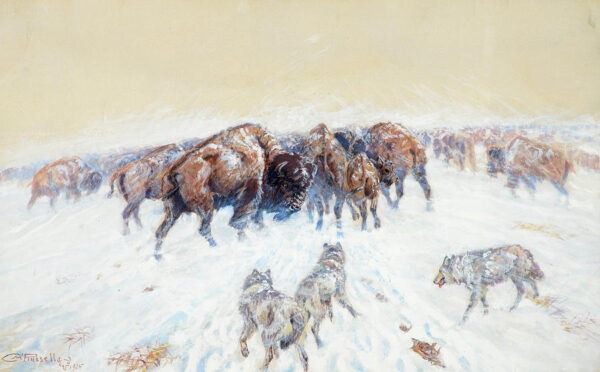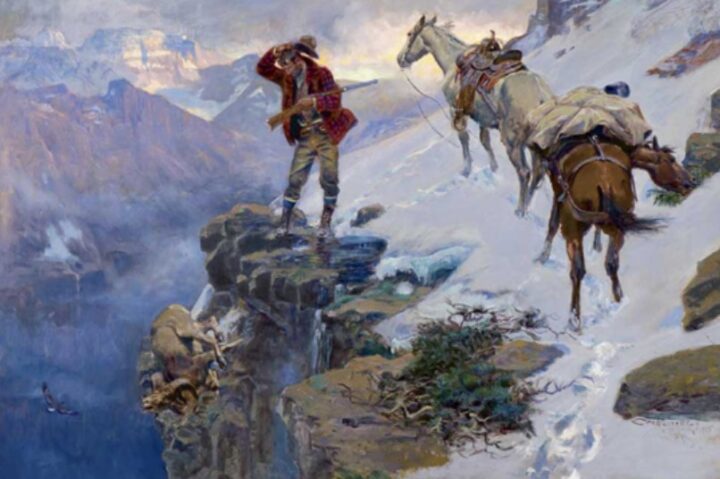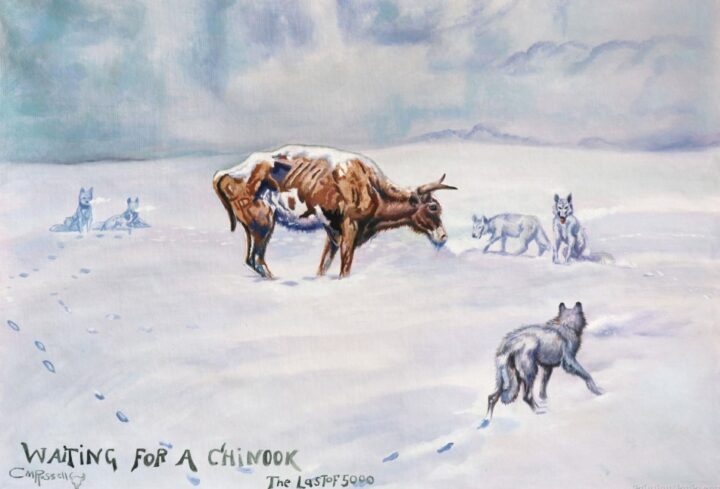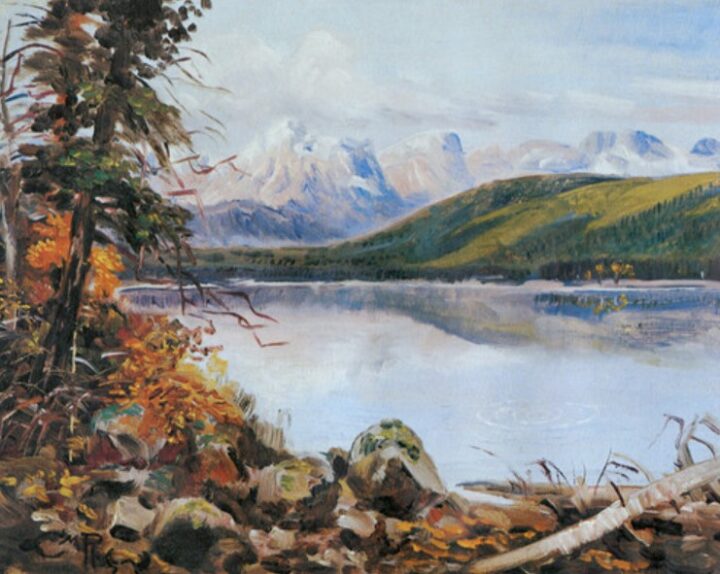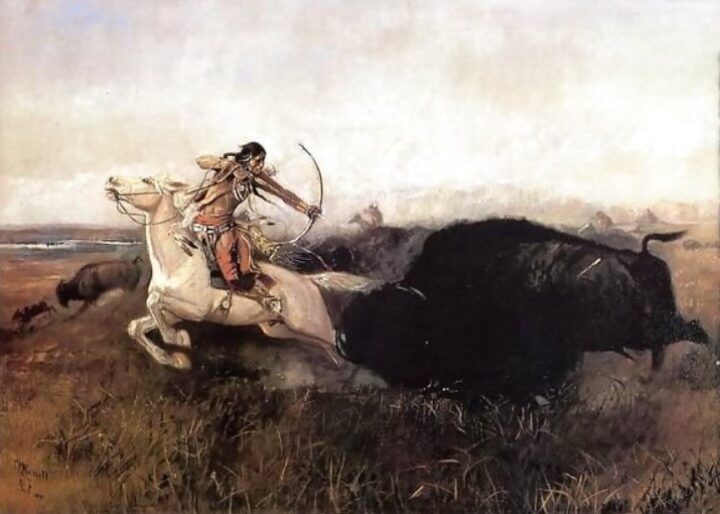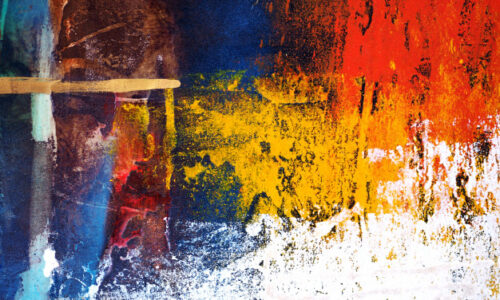Charles Russell, an artist from America, is widely known for his paintings of the American West. His winter scenes feature the majestic Rocky Mountains covered in snow, rolling hills blanketed by snow, and Native American tribes surviving the cold winter on the open prairie.
Russell’s winter scenes often feature beautiful sunsets, starry night skies, and the warm glow of a campfire. The colors of orange, red, and yellow from the setting sun combined with the white snow creates a beautiful contrast. Russell’s winter scenes are a testament to the beauty and grandeur of the American West.
The Snowy Range (1909)
This painting depicts a group of cowboys and horses silhouetted against the snow-covered mountains of the Rocky Mountains in Wyoming. The Snowy Range is one of the most iconic works of the Western artist Charles Russell’s career. It embodies his vision of the American West. The painting is now in the Whitney Gallery of Western Art collection in Cody, Wyoming.
Winter in the Rockies (1910)
This oil painting by Charles Marion Russell depicts a Native American camp in the Rocky Mountains during winter. The base is nestled in a small valley surrounded by snow-covered peaks. A stream runs alongside the camp, and many horses graze in the foreground. The camp includes several tipis, a wooden fence, and several people. The painting is composed in a loose, impressionistic style, with large areas of color. It conveys a sense of the stillness of winter, the beauty of the landscape, and the harmony between the people and the environment.
The Wolf Pack (1911)
The painting is a testament to Russell’s artistic skill and ability to capture the essence of the American West. This painting is one of the most important in the list of Charles Russell paintings, and it epitomizes the wildness of the West and the spirit of the American frontier.
Western artist Charles Russell Russell muted colors and loose brush strokes to give this painting a haunting, dream-like quality. The painting captures the beauty, strength, and mystery of the wolves, as well as the vastness of the American West.
The Trapper’s Last Shot (1912)
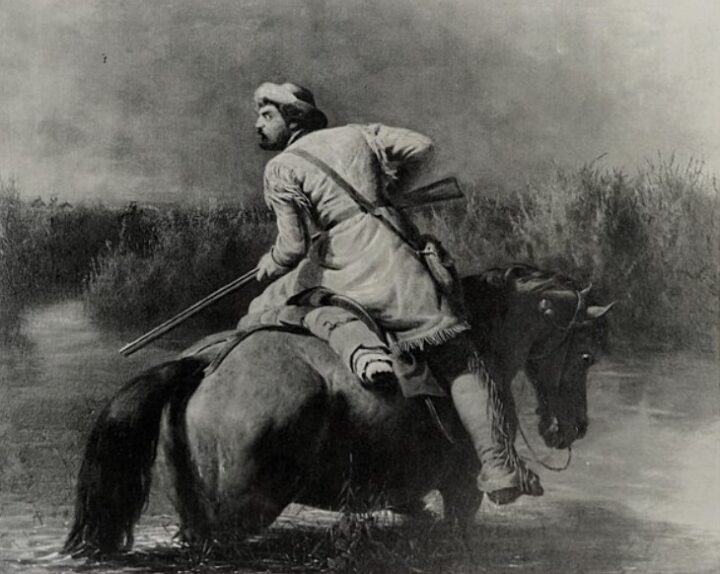
The painting is set against a backdrop of a distant mountain range and a clear blue sky. The trapper is seen in the foreground with a rifle, seemingly ready to aim. He is surrounded by his dogs, who appear to be paying attention to the target. In this Charles Russell painting, the trapper’s face is lit with determination and a hint of sadness. The painting is a reminder of the struggles of the early settlers and their determination to survive in the harsh environment of the American West.
On the Yellowstone (1913)
On the Yellowstone captures the majesty of Yellowstone in a way that few other paintings can, and it is considered one of his most important works.
The painting depicts a large herd of bison framed by a magnificent landscape of Yellowstone National Park. The vast herd of bison, arranged in a sweeping arc from the foreground to the distant mountain range, is highlighted by the vastness of the landscape. The yellow-orange sky provides a stunning backdrop for the bison and the landscape, emphasizing the vastness and beauty of Yellowstone.
Winter Camp (1914)
Winter Camp features a small group of Native Americans camped out in the winter with a tipi and a campfire. The painting portrayed how the U.S. government treated Native Americans at the time and was meant to remind them of their struggle to survive. It shows a group of Native Americans, likely in Montana, gathered around a campfire and a tipi. Both wearing traditional clothing, a man and a woman can be seen near the fire. Snow-covered hills surround the camp, and a lone horse stands in the foreground. The painting is meant to evoke a sense of serenity and the harshness of the winter landscape.
Return of the Buffalo Hunt (1915)
Return of the Buffalo Hunt features a scene of a Native American tribal hunting party returning to the camp after a successful buffalo hunt. The painting is richly detailed, with a large herd of buffalo, a line of mounted warriors, and a camp of tipis in the background. A Montana rancher originally commissioned the painting and is now in the collection of the C.M. Russell Museum in Great Falls, Montana.
Winter in the West (1916)
This painting is a classic of the Western genre and depicts a scene of a snow-covered ranch in Montana. In the foreground are a herd of horses and a cowboy on horseback, while in the background, a small herd of cattle is seen browsing in the snow. The painting features a beautiful landscape of rolling hills and distant mountains. The sky is filled with a vibrant pink and orange hue that reflects the setting sun. The painting gives a sense of peace and stillness as the animals, and the cowboy faces the coming of a cold winter night.
Winter Butte (1929)
Winter Butte is a 1929 novel by Marion Russell. It is set in a small Montana town in the 1920s and follows the lives of three generations of the Taylor family. It is about the family’s struggles with the harsh winter weather and their relationships. Throughout the novel, the Taylors must confront their prejudices and misconceptions about the world and come to terms with their mortality.
Conclusion
Charles Marion Russell was a talented painter and is considered one of the essential American Western artists of the 19th and 20th centuries. He was known for his paintings of cowboys, Native Americans, and landscapes of the American West.
Russell loved to paint winter scenes because he was captivated by the beauty of the winter landscape. For him, winter was a time of peaceful reflection and contemplation. He was inspired by the tranquility of the snow, the air’s calmness, and the countryside’s serenity. He believed that the beauty of winter was a reminder of the importance of living in harmony with nature.

